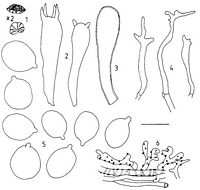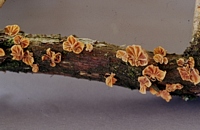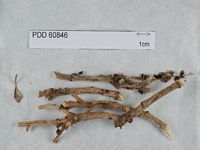|
 Anthracophyllum pallidum Anthracophyllum pallidum
BiostatusPresent in region - Indigenous. Endemic
Images (click to enlarge)
Caption: 1, Basidiomes x2; 2, basidia; 3, sclerified basidium; 4, hyphoid cheilocystidia; 5, spores; 6, pileipellis elements. (Magnifications, see Fig. 1.) | 
Caption: REB 1592
Owner: Ross Beever | 
Caption: Dried type specimen
Owner: Herb PDD |
Article: Segedin, B.P. (1994). Studies in the Agaricales of New Zealand: new records and new species of the genera Cheimonophyllum, Mniopetalum, and Anthracophyllum (Tricholomataceae, Collybieae). New Zealand Journal of Botany 32: 61-72 (http://www.rsnz.org/publish/abstracts.php).
Description: Basidiome 6-8 mm diam., sometimes stipitate, orbicular to reniform (basally cordate) to conchate. Pileus dry, radially sulcate following the lamellae, margin slightly crenate; surface dark vinaceous (9D3), with small, blackish, warty patches. Hymenophore flesh coloured (7B5), fawn (7C4) when dry, either smooth or lamellate, with 1-5 principal lamellae converging laterally towards the margin or to a smooth, sublateral point, sometimes with a second series of short lamellae; no interveining. Lamellae often fairly shallow and distant, margin rounded and concolorous. Stipe lateral, very short, curved, concolorous with hymenophore, surface pruinose. Smell and taste unknown. Spore print unknown.
Spores 8-14 x 8-10 (9.2 x 8.2) µm, Q = 1.1, very variable in size and shape, the smaller ones being nearly spherical and the larger ones ovoid to elliptical, hyaline, not staining in KOH, inamyloid, not dextrinoid, acyanophilic, smooth, thin-walled, apiculus prominent. Basidia 50-75 x 5-14 µm, conspicuously large, elongate clavate, occasionally sclerified, (2)-4-spored, sterigmata stout. Hyphoid cheilocystidia and pleurocystidia present, 40-55 x 5 µm, with 1-5 short, apical branches, found among the basidia on lamellar edge and face. Trama of closely packed narrow (2-3 µm diam.) hyphae with thick, glassy-looking walls. Subhymenium a narrow zone of more loosely interwoven hyphae. Lower context of narrow (2-3 µm diam.) closely packed hyphae like the trama, upper part of the context of more loosely interwoven hyphae. The pileipellis consists of more or less repent hyphae 4-5 µm diam., often conspicuously encrusted with black granules turning to dark blue green in KOH. From these arise a tangle of narrower, diverticulate to almost Rameales hyphae, 15-25 x 2 µm, with conspicuous blobs of green staining pigment on their walls. Frequent, spherical aggregations of these hyphae are responsible for the dark, floccose appearance of the pileus. Stipe surface also of Rameales structure, some of the hyphal endings encrusted with blobs of pigment, turning intensely green in KOH. No brown extractable pigment present in the basidiome. All hyphae with conspicuous, almost medallion-like, clamp connections.
Habitat: Gregarious on twigs in indigenous forest, collections as yet confined to Olearia furfuracea.
Notes: This species differs from the two species described above in the consistently pale colour of the hymenophore and the dark, granular pileal surface. In some respects, such as pale colours of hymenophore and huge basidia, both A. glaucophyllum and A. pallidum resemble the Venezuelan species A. andinum Dennis, but have much smaller basidiomes, slightly smaller spores (A. glaucophyllum), and lack the conspicuous interveining which appears to be a feature of A. andinum (Pegler & Young 1989).
|